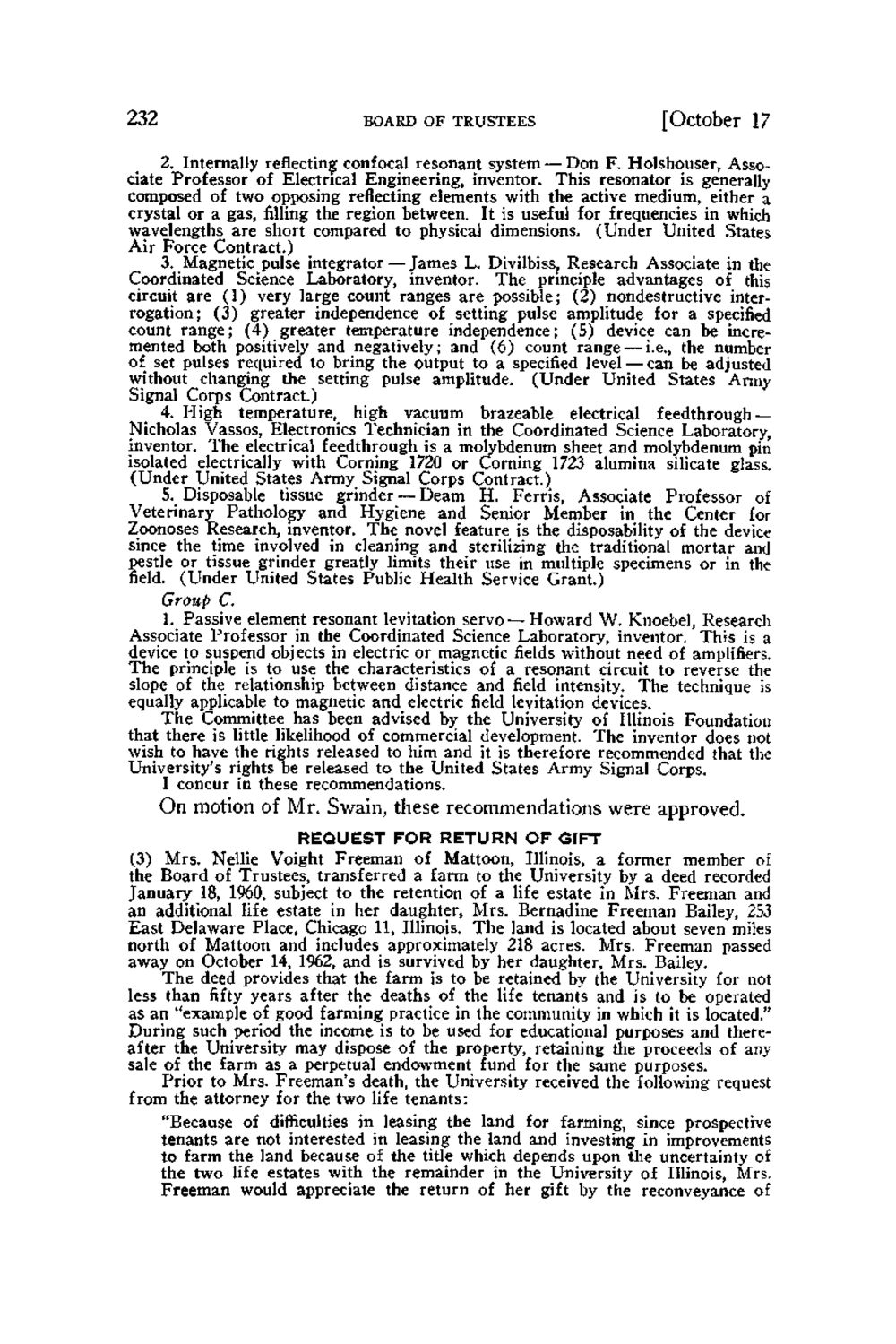| |
| |
Caption: Board of Trustees Minutes - 1964
This is a reduced-resolution page image for fast online browsing.

EXTRACTED TEXT FROM PAGE:
232 BOARD OF TRUSTEES [October 17 2. Internally reflecting confocal resonant system — Don F . Holshouser, Associate Professor of Electrical Engineering, inventor. This resonator is generally composed of two opposing reflecting elements with the active medium, either a crystal or a gas, filling the region between. It is useful for frequencies in which wavelengths are short compared to physical dimensions. (Under United States Air Force Contract.) 3. Magnetic pulse integrator — James L. Divilbiss, Research Associate in the Coordinated Science Laboratory, inventor. The principle advantages of this circuit are (1) very large count ranges are possible; (2) nondestructive interrogation; (3) greater independence of setting pulse amplitude for a specified count r a n g e ; (4) greater temperature independence; (5) device can be incremented both positively and negatively; and (6) count range — i.e., the number of set pulses required to bring the output to a specified level — can be adjusted without changing the setting pulse amplitude. ( U n d e r United States Army Signal Corps Contract.) 4. High temperature, high vacuum brazeable electrical feedthrough — Nicholas Vassos, Electronics Technician in the Coordinated Science Laboratory, inventor. The electrical feedthrough is a molybdenum sheet and molybdenum pin isolated electrically with Corning 1720 or Corning 1723 alumina silicate glass. ( U n d e r United States Army Signal Corps Contract.) 5._ Disposable tissue grinder — Deam H. Ferris, Associate Professor of Veterinary Pathology and Hygiene and Senior Member in the Center for Zoonoses Research, inventor. T h e novel feature is the disposability of the device since the time involved in cleaning and sterilizing the traditional mortar and pestle or tissue grinder greatly limits their use in multiple specimens or in the field. (Under United States Public Health Service Grant.) Group C. 1. Passive element resonant levitation servo— Howard W . Knoebel, Research Associate Professor in the Coordinated Science Laboratory, inventor. This is a device to suspend objects in electric or magnetic fields without need of amplifiers. T h e principle is to use the characteristics of a resonant circuit to reverse the slope of the relationship between distance and field intensity. The technique is equally applicable to magnetic and electric field levitation devices. T h e Committee has been advised by the University of Illinois Foundation that there is little likelihood of commercial development. T h e inventor does not wish to have the rights released to him and it is therefore recommended that the University's rights be released to the United States Army Signal Corps. I concur in these recommendations. On motion of Mr. Swain, these recommendations were approved. REQUEST FOR RETURN OF GIFT (3) Mrs. Nellie Voight Freeman of Mattoon, Illinois, a former member of the Board of Trustees, transferred a farm to the University by a deed recorded January 18, 1960, subject to the retention of a life estate in Mrs. Freeman and an additional life estate in her daughter, Mrs. Bernadine Freeman Bailey, 253 East Delaware Place, Chicago 11, Illinois. The land is located about seven miles north of Mattoon and includes approximately 218 acres. Mrs. Freeman passed away on October 14, 1962, and is survived by her daughter, Mrs. Bailey. T h e deed provides that the farm is to be retained by the University for not less than fifty years after the deaths of the life tenants and is to be operated as an "example of good farming practice in the community in which it is located." During such period the income is to be used for educational purposes and thereafter the University may dispose of the property, retaining the proceeds of any sale of the farm as a perpetual endowment fund for the same purposes. Prior to Mrs. Freeman's death, the University received the following request from the attorney for the two life tenants: "Because of difficulties in leasing the land for farming, since prospective tenants are not interested in leasing the land and investing in improvements to farm the land because of the title which depends upon the uncertainty of the two life estates with the remainder in the University of Illinois, Mrs. Freeman would appreciate the return of her gift by the reconveyance of
| |